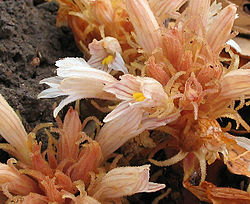| Orobanche vallicola | |
|---|---|
 | |
| Scientific classification | |
| Kingdom: | Plantae |
| Clade: | Tracheophytes |
| Clade: | Angiosperms |
| Clade: | Eudicots |
| Clade: | Asterids |
| Order: | Lamiales |
| Family: | Orobanchaceae |
| Genus: | Orobanche |
| Species: | O. vallicola |
| Binomial name | |
| Orobanche vallicola (Jeps.) Heckard | |
Orobanche vallicola is a species of broomrape known by the common name hillside broomrape or valley broom rape. [1]
Contents
It is endemic to California and grows in forest openings and woodlands. [2]
